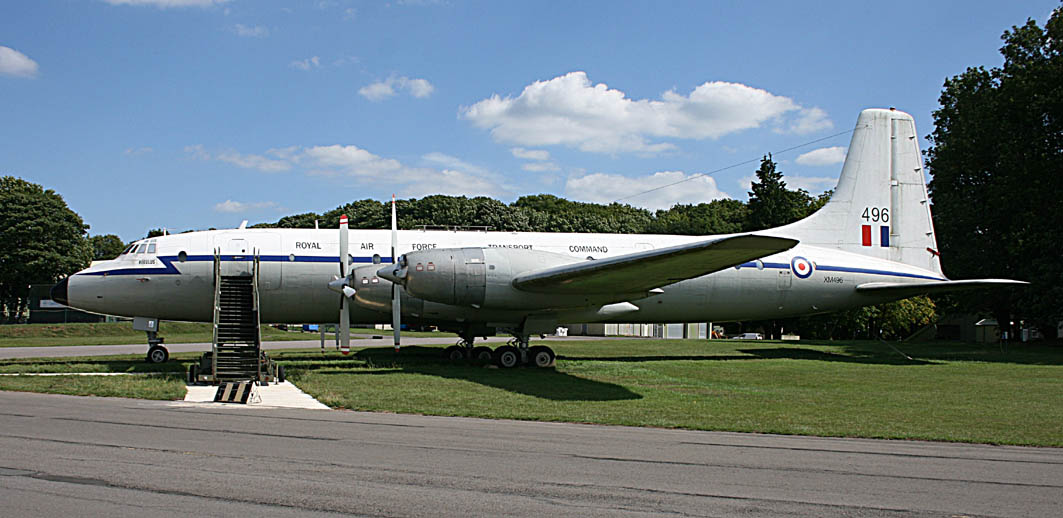
Bristol Britannia
 |
| Britannia C1 XM496 Britannia Aircraft Preservation Trust at Kemble, Gloucestershire, in the UK. |
| The Bristol Britannia is considered by many as the ultimate turboprop
engined airliner - certainly anyone who saw one fly could not have failed to
have been impressed by its sheer majesty. But as a commercial project it must rank as an abject failure - just 85 were built and the type's prolonged development saw it overhauled by jets just when the project was finally getting off the ground. While a key factor in its delayed entry into service was the inevitable problems experienced with a new technology - in this case turboprop engines - a major factor was the rather arcane British system of ordering aircraft which existed at the timeand which was to lead to numerous redesigns. So closely was the type tailored to BOAC's needs that the result was to be an aircraft which had limited appeal to other airlines and, in a situation that was to blight other types such as the Comet, VC10 and Trident, was to hand the lion's share of the world airliner market to the far more commercially aware giants of Boeing and Douglas. The initial requirement C2/47 was issued by the Ministry of Supply on behalf of BOAC for a medium range Empire airliner. BOAC initially ordered an aircraft capable of carrying just 48 passengers and powered with Centaurus radial engines. Turboprop and compound engines were also considered but Bristol would not guarantee the aircraft's ability to fulfill the specification with these engine types. After wrangling between the MoS and BOAC over costs the go-ahead was given in July 1948 for three radial-engined prototypes, although the second and third were to be convertible to Proteus turboprops. But in October BOAC threw the project into confusion by deciding a Proteus-engined aircraft deserved a start and the project was now redrawn to allow for both turboprop and piston aircraft. BOAC finally signed up for 25 aircraft in July 1949, the first six with the Centaurus engine and the rest with the Proteus, and now enlarged for 74 passengers. By the time the first prototype took to the air on August 16, 1952 BOAC and Bristol had dropped the Centaurus plan as the turboprop Proteus had shown such promise. The Britannia was now a 90-seater and BOAC ordered 15 series 100s. Sadly a series of engine problems - mostly centred on icing - was to delay the in-service date until February 1957, when BOAC put its first Britannia 102s into service on the London to South Africa route, with Australia following a month later. The ultimate model was the 300 series ordered by BOAC for its Trans-Atlantic services. This had a fuselage stretched by 10ft 3 in (3.12m) and 45 were built. But by the time it flew in the shape of 301 G-ANCA, on July 31, 1956 the jet age was just around the corner. BOAC ordered seven 302s but never took delivery of them - instead they were taken on by several other airlines including Aeronaves de Mexico and Ghana Airways. The main long range version was the 312, of which BOAC took 18 and, after deliveries began in September 1957, put them into service between London and New York. The Royal Air Force took delivery of 25 series 252 and 253 long fuselage versions with a forward freight door and a specification basically similar to the 310. The final version was the 320 with uprated Proteus 765s although just two - for Canadian Pacific- were built in this series as 324s. Several in the 310 series were also completed to this standard. In addition, Canadair developed its CL-28 Argus maritime patrol aircraft based on a heavily modified Britannia fuselage. The aircraft featured four Wright R-3350-32W Turbo-compound engines to give greater range at low level and an interior crammed with electronics and a weapons bay. Thirty-three of the type were built and they served with the Royal Canadian Air Force from the late 1950s in the 1980s. BOAC retired its Brits from 1965, many passing to British Eagle, and these gave sturdy service along with those of Britannia Airways and Monarch in the British charter market until the early 1970s. A new lease of life came in the mid 1970s when several RAF freighters came on to the market and were snapped up by British, European and African carriers. The type slowly dwindled in number until the end came with the final flight of EL-WXA to preservation at Kemble in England in 1997. |
| Contents | Photos and census | Update |